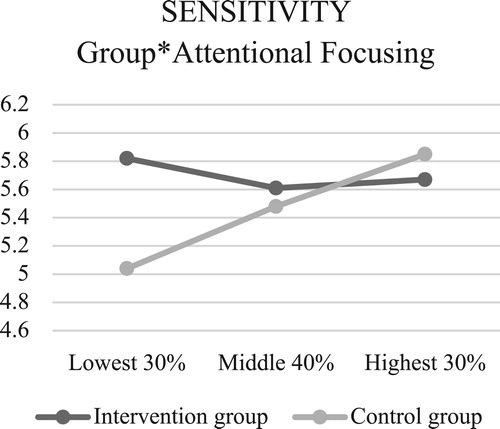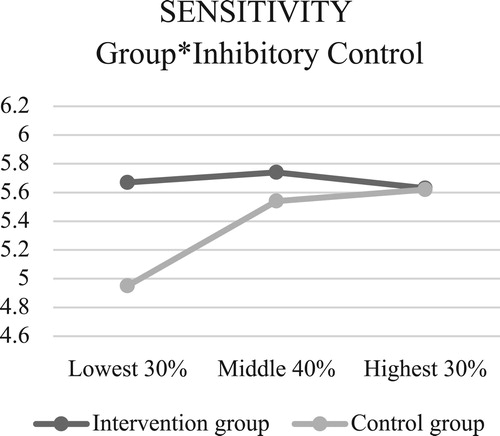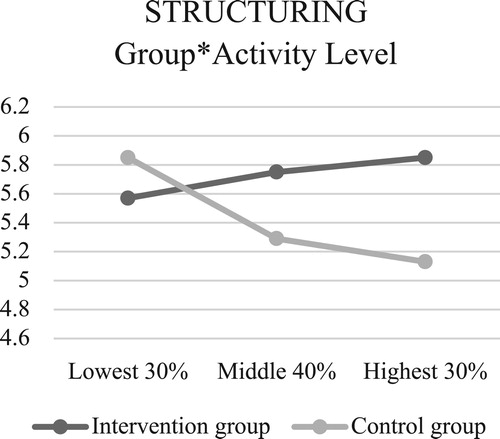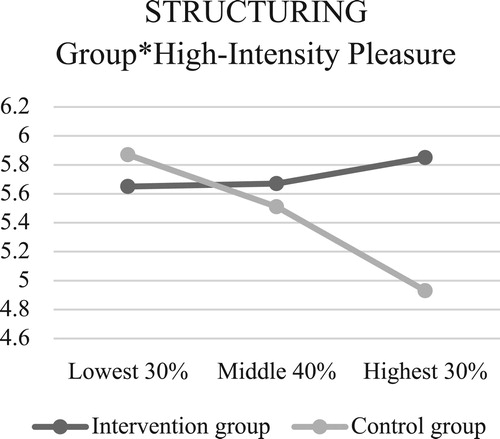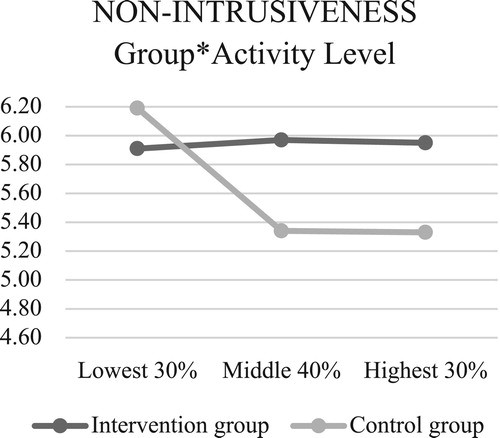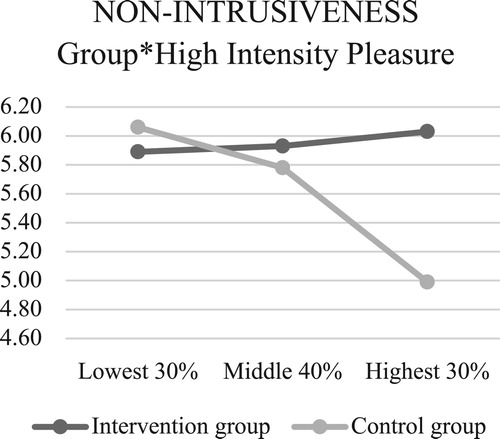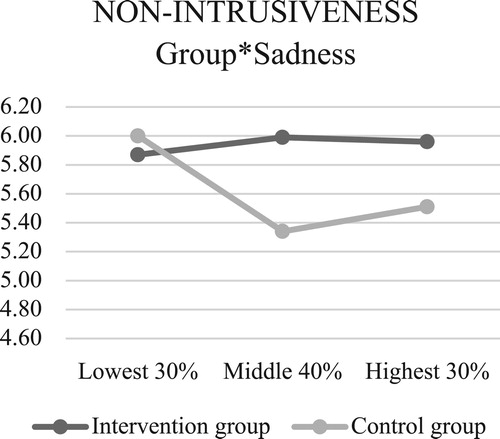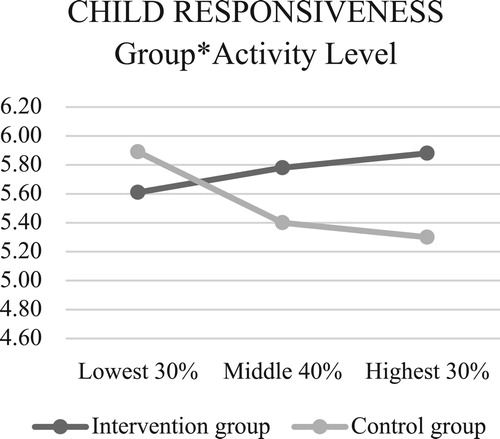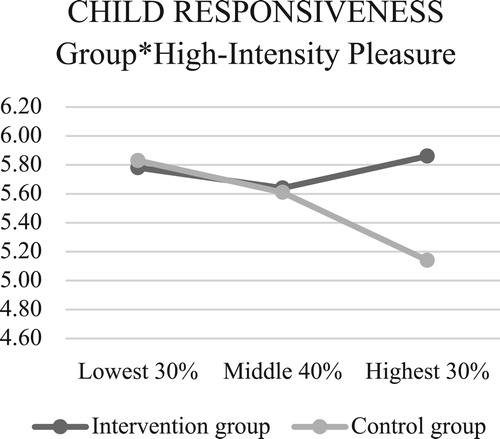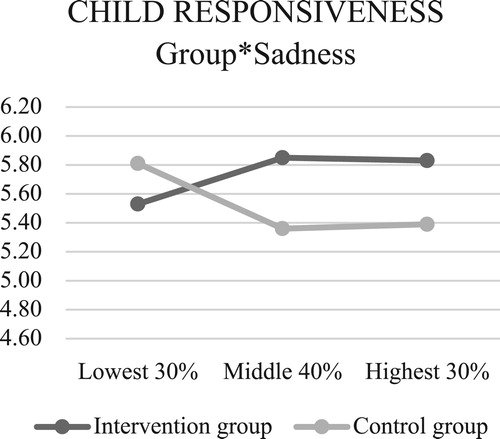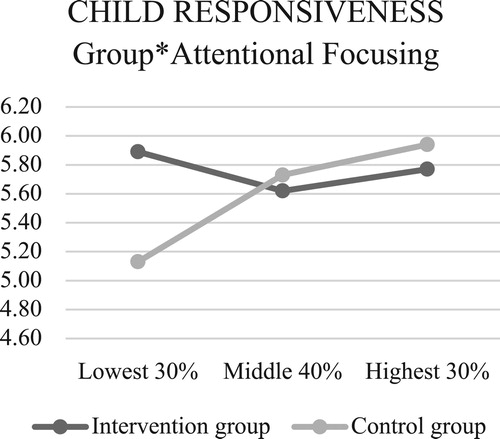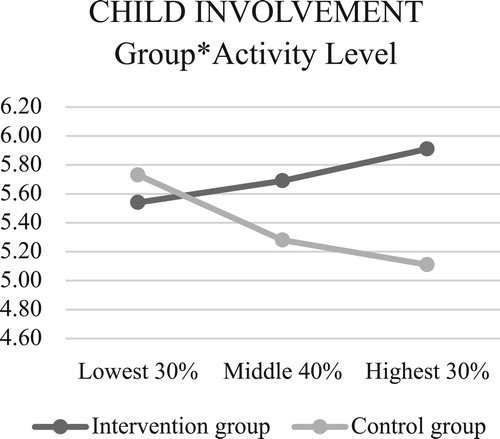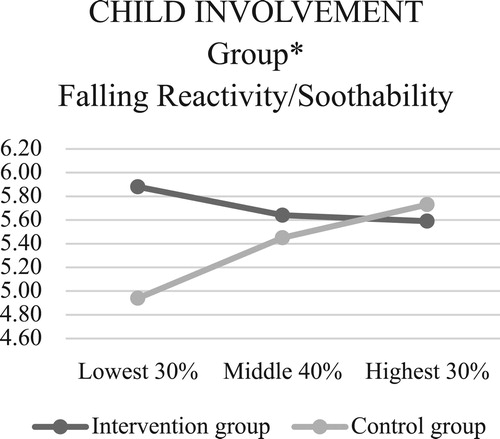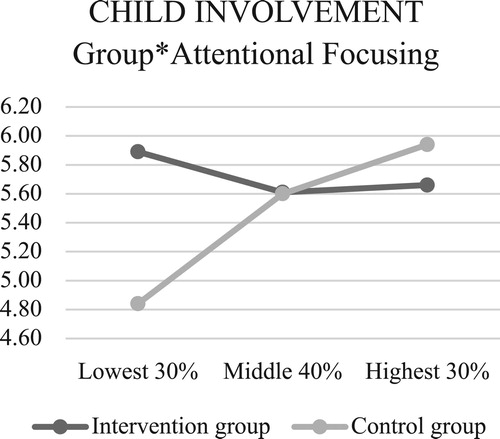ABSTRACT
The purpose of this study was to evaluate the impact of pedagogical intervention on early childhood education professionals’ emotional availability to children with different temperament characteristics. Participants were 136 children (intervention group = 87; control group = 49) aged 1–6 years from 16 early childhood and care centres in Finland. The PedaSens intervention was a 9-month programme that included theory and video-based training for the professionals. Adult–child interaction was assessed with the Emotional Availability Scales before and after the intervention, and children’s temperament was assessed with the Early Childhood Behavior Questionnaire. According to results, early childhood professionals’ emotional availability increased in the intervention group, especially to children with high levels of activity and pleasure seeking and with low levels of attentional focusing. We argue that the quality of interaction in early childhood education and care can be increased by targeting professional trainings to support children with different temperament characteristics.
Introduction
The results of the Starting Strong Survey 2018 have indicated that the quality of staff-child interactions in early childhood education and care (ECEC) centres varies within the Organisation for Economic Co-operation and Development (OECD) countries. The quality differences depend, for example, on the diversity of children with different backgrounds and various needs in the classrooms (OECD Citation2019). In this study, we focused on the quality of interaction in ECEC in light of children’s individual characteristics. Specifically, we assessed the impact of pedagogical intervention on early childhood professionals’ (ECPs’) emotional availability to children with different temperament characteristics.
The quality of interaction is an essential part of the process quality in the context of ECEC (Slot et al. Citation2015). Several international studies have indicated teacher interaction as an essential quality factor of ECEC, providing a positive impact on children’s developmental and learning outcomes as well as social competence (Brock and Curby Citation2014; Mashburn et al. Citation2008). Effective interaction could be defined as the teacher’s ability to create an emotionally supportive environment using a warm tone and positive affect in communication. The teacher is able to consider children’s perspectives in teaching and give them autonomy, as well as being sensitive to their needs and emotions (Goble, Sandilos, and Pianta Citation2019). Furthermore, interaction quality could be described through the concept of emotional availability, referring to the affect and behaviour of the adult–child interaction considering both sides of the interaction (Biringen Citation2000). In the context of this study, pedagogical sensitivity is a combination of the theoretical aspects of high-quality interactions and practical components, such as pedagogical practices used to support children’s age-appropriate development and learning. In addition, we emphasise that a high-quality interaction often requires considering children’s temperament as an essential part of the interaction, especially in the group context (Suhonen and Sajaniemi Citation2012; Sajaniemi et al. Citation2015; Nislin Citation2016).
Recently, the resources for developing high-quality interactions have been invested on targeted intervention programmes with trainings, such as video guidance and individualised feedback provided for the ECPs (Fukkink and Tavecchio Citation2010; Werner et al. Citation2016). For instance, Biringen and colleagues (Citation2012) studied the effects of the intervention, including informational and practical training on ECPs’ emotional availability for infants and toddlers. As a result, professionals’ ability to structure interactions increased and children became more emotionally connected and emotionally responsive to the professionals (Biringen et al. Citation2012). The professional–child interaction should be supported in ECEC because high-quality interaction predicts children’s cognitive and socio-behavioural development in pre-school and at school entry (Sylva et al. Citation2006; Sylva et al. Citation2004). In addition, high-quality interaction predicts social competence and fewer problem behaviours, and also promotes academic outcomes for low-income children in pre-kindergarten (Brock and Curby Citation2014; Buschinal et al. Citation2010).
Meanwhile, the number of intervention studies has increased in ECEC, and knowledge about the quality of child care and teacher–child relationships in relation to children’s temperament characteristics seems to be relatively unexplored (De Schipper, Tavecchio, and Van IJzendoorn Citation2008; De Schipper et al. Citation2004; Rudasill and Rimm-Kaufman Citation2009).
Previous temperament research is abundant in the field of psychology, focusing on the development and personality of the children (Rothbart and Bates Citation2006). According to Rothbart and colleagues, temperament is constitutionally based on individual differences in reactivity and self-regulation, and it includes attentional reactivity, emotionality and motor activity (Rothbart and Bates Citation2006; Rothbart and Derryberry Citation1981). In other words, children react differently to the events in their surrounding environment based on inborn activity, emotion and attention. Children’s ability to regulate these reactions are in the centre of the definition of temperament (Rothbart and Rueda Citation2005). By the definition of reactivity and self-regulation, temperament traits are relatively consistent across situations and stable over time (Rothbart and Bates Citation2006). It has biological makeup influenced over time by individual’s heredity, maturation and experience. The basic biological processes of temperament can be recognised in different cultures. However, the socio-emotional environment, cultural values and experiences of the child channel the outcomes of the temperament (Rothbart Citation2007; Rothbart and Derryberry Citation1981; Bugental and Grusec Citation2006).
Temperament and other biological givens together with environmental factors influence the developmental processes of the child (Suhonen et al. Citation2018). Chess and Thomas (Citation1991) have defined the concept ‘goodness of fit’ as a condition where the child’s temperament and other characteristics, such as motivations and intellectual abilities, are sufficient to master the demands, expectations and opportunities of the environment. Consequently, goodness of fit provides favourable progress of functioning and psychological development (Chess and Thomas Citation1991). To support children’s healthy development, ECPs should be able to recognise different temperaments and other biological characteristics and adjust their pedagogical practices and interaction according to them.
To highlight the key aspects of the previous research on ECP-child interaction and children’s temperament, we approach the issue through three temperament constructs: effortful control (EC), surgency and negative affectivity (NA) (Rothbart and Bates Citation2006). EC is an essential temperament construct and part of the processes responsible for children’s self-regulation. It is the ‘children’s ability to choose a course of action under conditions of conflict, to plan for the future, and to detect errors’ (Rothbart Citation2007, 207). Rudasill and Rimm-Kaufman (Citation2009) studied the relation between 4-year-old children’s EC and the teacher–child relationship when the children reached first grade in school. As a result, children with high EC had closer relationships with teachers. On the contrary, children with low EC had more conflicts with teachers and experienced more teacher-initiated interactions (Rudasill and Rimm-Kaufman Citation2009). In addition, children with low EC are at risk of developing externalising behavioural problems (Eisenberg, Smith, and Spinrad Citation2004; Eisenberg et al. Citation2005). In the context of ECEC, these children may receive more insensitive interaction, such as negative and controlling discipline, from the professionals. This is a potential threat to children’s healthy development, knowing that insensitive interaction may cause increased vulnerability to stress (Tarullo and Gunnar Citation2006).
Surgency characterises children high in activity, positive affectivity and impulsivity without showing shyness or withdrawal (Dollar and Stifter Citation2012; Rothbart Citation1994). Basset and colleagues (Citation2017) studied how teachers’ reactions to children’s emotions predicted preschool children’s social-emotional behaviour and how surgency moderates these relations. According to the results, children with low surgency were more sensitive to both positive and negative types of teachers’ reactions on their social-emotional behaviours compared to children with high surgency. It seems that these children are learning social-emotional behaviour by observing interactions in the classroom, highlighting the role of the teacher for children’s socio-emotional behaviour. On the contrary, high-surgency children’s active orientation to ongoing activity and peer relationships may reduce the children’s awareness of teacher–child interactions (Bassett et al. Citation2017). This may result in a decrease in learning experiences about social-emotional behaviours.
NA characterises children experiencing fear, discomfort, sadness, shyness and frustration, and they have difficulties settling down (Rothbart and Putnam Citation2002). In the context of the parent–child interaction, higher emotional availability of the parent seems to buffer stress hormone cortisol elevation of socially inhibited children in stressful situations (Kertes et al. Citation2009). This is an important perspective, considering that differences in cortisol levels during the day reflect a stress response of the physiological systems also known to impact children’s brain development (Dettling, Gunnar, and Donzella Citation1999; Gunnar and Vazquez Citation2001). In ECEC, ECPs’ sensitive and supporting interactions may protect children from harmful stress responses.
The current study
The aim of this study is to investigate the impact of pedagogical intervention on the quality of early childhood professionals’ (ECPs’) interactions regarding children’s temperament. More precisely, we explored whether an intervention programme targeted to enhance ECPs’ pedagogical sensitivity can diminish the impact of children’s temperament on professionals’ emotional availability. We hypothesise that after the intervention, ECPs who receive training are more sensitive to support children with different temperament characteristics and adjust their behaviours accordingly than those without training.
PedaSens training is designed to raise ECPs’ knowledge of pedagogical sensitivity, using both theoretical information and video materials collected from study groups. Theoretical and practical information included, for instance, knowledge on emotional availability, co-regulation and children’s individual temperament traits. ECPs in the intervention group (IG) received the intervention training in the beginning of the study, and it was offered to the control group (CG) after the research period. The PedaSens intervention study was piloted during the years 2013–2016 to test the intervention design and the training for professionals in ECEC classrooms.
Methods
Characteristics of the research participants
Study participants included 64 early childhood professionals (ECPs) and 136 children in Finnish ECEC centres. The recruitment was executed in collaboration with ECEC management and health services in four cities. Professionals were informed about the study with informational sessions and invitation letters, and they had the possibility to discuss their participation with the management and research group. It was important that all centres and teams had equal premises to participate in the study. Hereafter, children’s parents received information letters, and their participation was confirmed with written consent.
Participating classrooms were randomised into IGs and CGs. Random selection and assignment took place at the classroom level (rather than at the ECEC centre level), allowing different classrooms within the same ECEC centre to be in different study groups. This allowed us to ensure that there was approximately the same number of ECPs, and different-age classrooms would be included in both study groups. Nonetheless, some of the CGs refused to participate as a comparison group without immediate training. The decision considering the randomisation is discussed further in the limitations section.
The original pool of the sample was 16 ECEC centres, 24 classrooms and 274 children. One of the centres was private and the rest were public. According to the ECPs, children participated in ECEC at least 20 h per week, except children in ECEC with extended opening hours (response rate 91.3%). The final pool included 136 children with 87 in the IG and 49 in the CG, so approximately 49.6% of the children from the original pool (n = 274) participated in both pre- and post-test measurements. More than half of the children (50.4%) were excluded from the sample because they were not present in the classroom at the time when filming was carried out or they had moved to another centre. In the beginning of the study, children’s ages ranged between 11 and 80 months. A minimum of 2 and maximum of 12 children in every classroom were included in the study. The need for special support for nine children was based on a pedagogical assessment and a statement from an expert. Background characteristics of the children in relation to the study group are described in .
Table 1. Characteristics of children and classroom.
A total of 74 ECPs were in the original pool, and 64 (intervention: 39; control: 25) of them were included in the final sample. Selection was based on their presence in the video with the children included in follow-up measurements. ECP ages ranged between 23 and 62 (response rate 95.3%), and the majority were female (96.9%). Approximately 7.8% of the ECPs had worked in the ECEC field for 3 years or less, 15.6% for 3–10 years and 68.8% for 10 years or more (response rate 92.2%). Their education level was early childhood education teacher with university training (Bachelor’s/Master’s degree in Education, 28.1%), social services training in an applied university (Bachelor’s degree in Social Services, 15.6%) and nursery nurse/group assistant with vocational school training (56.3%). According to the managers of the ECEC centres, classrooms did not have any other intervention programmes that might have had any impact on the quality of interactions.
Measures
Emotional availability scales
The research data were collected with the help of ECEC staff in the centres. Video observations were conducted in the classrooms before the intervention training and approximately 9 months (intervention: M = 9.22, SD = 1.28; control: M = 9.15, SD = 0.58) after the beginning of the intervention. Video observations were completed during the daily activities in the classrooms with one early childhood professional (ECP) and 1–8 children present in the interaction. The aim was to capture natural real-life situations and pedagogical activities. The mean duration of the videos was 25.37 min (range 10.24–48.05 min), and because of technical and practical reasons, approximately 5% of the videos were less than 20 min long. These videos were included in the study because of the coverage of the research data. The total amount of video data was approximately 44 h.
The quality of interaction was assessed from the video data with Emotional Availability (EA) Scales (Biringen Citation2008). EA Scales is an internationally standardised assessment method, and several studies have established its construct validity and the stability of the measure over time (Easterbrooks and Biringen Citation2000; Biringen Citation2005). The dimensions of the scale are adult sensitivity, structuring, non-intrusiveness and non-hostility and child responsiveness and involvement in interactions between ECPs and children. Dimensions were rated on a 7-point scale or a 3-point scale with a maximum total score of 29 and 7 as a direct score. Althought the video observations were multi-part interactions, every dyadic interaction (a total of 272 interactions) between an ECP and child was assessed separately with an analysing unit (1–7) for the interaction quality.
In this study, the dimensions of the EA were assessed by a trained and certified (LEVEL I & II with Zeynep Biringen) researcher after several viewings of the videos. Interrater reliability (approximately 26% of the video observations) was achieved by using the intraclass correlation coefficient (ICC) at r > 0.80 with the assistance of an external EA-trained researcher who was blind to background information, such as study group membership of the children and ECPs. The ICC for adult sensitivity was 0.85, structuring 0.82, non-intrusiveness 0.81, non-hostility 0.89 and child responsiveness 0.86 and involvement 0.89. Challenging interactions were discussed with a third expert to find a consensus for the EA assessments.
Children’s Behavior Questionnaire
The Children’s Behavior Questionnaire (CBQ) and Early Childhood Behavior Questionnaire (ECBQ) for parents were used to assess children’s individual differences in temperament (Putnam, Gartstein, and Rothbart Citation2006; Rothbart et al. Citation2001). The questionnaires included a Likert-type scale of 1=never, 4=about half of the time and 7=always. The dimensions used in the study are activity level, anger/frustration, positive anticipation/anticipation, attentional focusing, discomfort, falling reactivity/soothability, fear, high-intensity pleasure, impulsivity, inhibitory control, low-intensity pleasure, perceptual sensitivity and sadness (see appendix). These dimensions were selected in the study based on the consistency across ages of the children, and they are parts of the big three temperament factors of EC, surgency and NA (Gartstein, Putnam, and Rothbart Citation2012; Putnam, Ellis, and Rothbart Citation2001; Putnam, Rothbart, and Gartstein Citation2008). The reliability of the temperament dimensions was evaluated with a satisfying result of Cronbach’s α 0.641–0.910.
Intervention procedure
The intervention procedure was started by collecting video data from the participating classrooms, and the data were assessed with Emotional Availability (EA) Scales and edited by the researcher (phase 1). Then followed a second phase as a 3-month training period that included five 90-minute supervision sessions between the ECP team and a trained supervisor. The main content of the intervention consisted of theoretical and practical information on emotional availability, co-regulation and children’s individual temperament traits that were delivered to participants in the first supervision session. This information was also used in the video-based reflection in sessions 2–4. Video examples (session 2) and episodes recorded of each ECP with the children in the classrooms (sessions 3–4) were planned to support individual and team reflection. It was ensured that every ECP received individualised and practice-oriented feedback that was discussed in the teams.
During the last session, ECPs were introduced to the reflective diary, including theory-based questions about their personal interactions and teamwork in the classrooms (phase 3). On a regular basis, the diary offered an opportunity to discuss useful practices in relation to characteristics of the children in the group. The instruction was to fill the diary at least once per month until the end of the research period, which lasted approximately nine months. Besides the professionals’ support, the diary had an important function for the researchers; it was used to confirm the fidelity of the study – that is, to make sure participants in the IG were acting according to the contents of the training.
Approximately 6 months after the beginning of the intervention there was another collection of video data (phase 4). After the data were assessed and edited, half of the ECPs in the IG received an extra (sixth) supervision session. This was given to provide more knowledge on long-term support. The effect of the extra training in terms of EA and temperament was tested beforehand, and these two training groups did not differ in the main results. Consequently, both groups were combined as one IG.
Ethical considerations
The study was approved by the Ethics Committee on Human Studies at the University of Helsinki. Written consent forms were received from children’s parents and the early childhood professionals (ECPs). They were informed about the research and data collection. The right to cancel participation was given to all participants without any specific reason for dropping out from the study. They could also have their data removed from the study regardless of the time when the data were collected.
Specific ethical instructions were used in the video observations to protect childreńs voluntary participation and wellbeing in the group. Considering the circumstances and children’s young age, accents from the children were not gained verbally, but ECPs and their supervisors were instructed to observe children during the filming based on their appearances and verbal and nonverbal expressions. Supervisors conducting the filming were also instructed to arrive in the classroom in advance to spend some time with the children and to tell them about the purpose of the filming. Children were told that during the filming they could tell the adults if they were feeling uncomfortable and ask the adults to stop filming. The filming had to be paused if the children were feeling uncomfortable, and this behaviour was clearly caused by the child being disturbed by the camera. Young children could express this, for example, by looking at the camera, crying or moving away from it. Children closer to six years old could express their discomfort by mentioning that they did not want to be filmed. However, in most cases, the children welcomed the camera with great interest and were curious about the purposes of the filming.
Statistical analyses
Normality of the data was evaluated with a descriptive statistics function. Independent samples t-test and Chi-Square test (Fisher’s exact test) were used to measure the independence of the background variables as well as the emotional availability (EA) and temperament values between the study groups. Pearson was used to measure the correlations between EA pre- and post-test variables and children’s ages. The Mann–Whitney U test was used to test the differences on EA post-test variables in relation to children’s background variables. Two-way analyses of covariance (ANCOVA) was used to investigate the differences in EA variables in relation to study group and childreńs temperament characteristics. ANCOVA was used on the basis that it enabled standardisation of the pre-test EA values; therefore, it improved the reliability of the study. All analyses were performed by the IBM SPSS statistical software (version 25), and the significance level was 5%.
Results
Preliminary analyses
The first phase of the analyses was to explore the potential covariates for the main analyses. Correlations between the emotional availability (EA) post- and pre-test variables, and also between EA post-test variables and background characteristics, were tested. Pearson correlation analyses showed statistically significant correlations between post-test and pre-test variables on adult EA variable sensitivity r = .212, p < .05; structuring r = .206, p < .05; non-intrusiveness r = .315, p < .001; and non-hostility r = .274, p < .005. No significant correlations were found between the pre- and post-test measurements on child responsiveness r = .153, p > .05 and involvement r = .112, p > .05. Moreover, analyses revealed a significant negative correlation between sensitivity and child’s age r = –.185, p < .05 (see ). The child’s age is considered an important background variable because the age distribution of the children is wide, and children from 1 to 6 years of age are included in the study.
Table 2. Correlations between the EA variables and children’s age.
The relation between post-test EA variables and other background characteristics was tested for surveying the potential covariates for the analyses. The Mann–Whitney U test did not reveal any significant differences on EA in relation to children’s gender, special support or language and cultural background.
The second phase was to analyse the differences between the IG and CG in EA pre-test variables. According to an independent sample t-test, there was a significant difference between the IG and CG on structuring (t[134]= –2.010, p = .046). No differences were found for other EA variables (p > .05). Means and standard deviations of the EA pre-test and post-test variables are described in .
Table 3. Means and standard deviations for the EA values at the pre-test and post-test measurements (N = 136).
Normality of EA post-test values between the study groups was evaluated by counting the z-scores for the skewness and kurtosis values and comparing them against the expected value +/– 1.96 (Field Citation2013). The normality assumption was fulfilled for most of the EA variables except non-hostility, which was removed from the main analyses. This was because hostile interaction is uncommon in ECEC, and most of the ECPs were assessed relatively high on this EA dimension.
Before the analyses, children’s temperament dimensions were transformed into z-scores and then to categorical variables. The first category included 30% of the lowest values, the second category 40% of the middle values and the third category 30% of the highest values. An interaction between children’s temperament and study group was tested before the main analyses, and the test revealed a significant difference between the study groups on impulsivity [X2(2, N = 136) = 6.1, p = .044] but not for other temperament dimensions (p > .05).
Impact of pedagogical intervention on early childhood professionals’ emotional availability to children with different temperament characteristics
In the ANCOVA, the emotional availability (EA) post-test variables were considered as dependent variables and the study group as an independent variable with temperament variables. EA pre-test values were used as covariates and based on the correlations (see ), and children’s age was used as a covariate with EA sensitivity. To ensure the reliability of the study, results were reported only for the analyses fulfilling the assumptions of equality of variances and homogeneity of regression slopes. Analyses considering the following results are conducted with IG (n=87) and CG (n=49), which are unbalanced in size, and this may affect reliability of the results.
Analyses revealed a significant interaction on EA sensitivity between the study groups and children’s temperament characteristics for attentional focusing [F(2,126) = 7.022, p = .001, η2 = .100] and inhibitory control [F(2, 128) = 3.986, p = .021, η2 = .059]. The result was positive, indicating that ECPs’ interaction in the IG was more sensitive to the children assessed low on these dimensions ( and ).
Consequently, interaction for EA structuring and activity level [F(2, 129) = 5.760, p = .004, η2 = .082] and high intensity pleasure [F(2,129) = 7.536, p = .001, η2 = .105] were also considered as positive impacts of the intervention. It reveals that in the IG, professionals’ interaction was more structured for the children assessed high on these dimensions ( and ).
For EA non-intrusiveness, results had an interaction with activity level [F(2,129) = 5.328, p = .006, η2 = .076]; high intensity pleasure [F(2,129) = 7.497, p = .001, η2 = .104] and sadness [F(2,129) = 3.241, p = .042, η2 = .048]. More precisely, in the IG, interaction was less intrusive for the children assessed high on these dimensions ().
Correspondingly, children’s EA responsiveness interacted significantly with activity level [F(2,129) = 4.263, p = .016, η2 = .062], high intensity pleasure [F(2,129) = 3.869, p = .023, η2 = .057] and sadness [F(2,129) = 4.066, p = .019, η2 = .059]. This means that compared to the CG, children in the IG were more responsive to the ECPs if they were assessed high on these dimensions. In addition, an interaction was also found for attentional focusing [F(2,128) = 5.595, p = .005, η2 = .080], indicating more responsiveness from the children with low levels of attentional focusing. The results are described in .
In the analyses of child EA involvement, the interaction was found for activity level [F(2,130) = 3.550, p = .032, η2 = .052], high intensity pleasure [F(2,130) = 3.814, p = .025, η2 = .055] and falling reactivity/soothability [F(2,130) = 4.358, p = .015, η2 = .063], indicating more involvement from the children in the IG assessed high on these dimensions. An interaction was also found for attentional focusing [F(2,128) = 6.841, p = .002, η2 = .097], meaning that children assessed low in this dimension were showing more initiatives to the ECPs. Results concerning the child EA involvement are described in . No other interactions were found between the EA variables and children’s temperament dimensions.
Discussion
Our study suggests that training targeted to enhance teacher’s pedagogical sensitivity can improve early childhood professionals’ (ECPs’) emotional availability for children with temperamental challenges, including challenges to focus their attention and to plan and suppress their inappropriate actions. In the IG, children with low attentional focusing were also more emotionally responsive and showed more initiatives to ECPs compared to the CG. The result was positive considering that attentional focusing and inhibitory control are important components of EC and self-regulation (Rothbart and Bates Citation2006). The results are in line with previous studies that indicate that high-quality interaction supports children’s self-regulating skills (Cadima et al. Citation2016). Emphasising the importance of this finding for children’s development, it should be noted that self-regulation skills learned in early childhood have short- and long-term effects to school readiness, academic skills, life management and health outcomes (McClelland, Acock, and Morrison Citation2006; McClelland et al. Citation2013; Mischel et al. Citation2011; Moffitt et al. Citation2011).
Intervention supported ECPs’ ability to provide positive and appropriate guidance for active children with high-intensity pleasure without controlling or interrupting the children. Children with this kind of temperament are physically active and oriented to the environment with a need for constant gratification. Considering their pleasure-seeking behaviour, these children need sensitive and regulatory support to engage in activities in ECEC, which might also protect them from negative developmental pathways. It is known that they are also at risk of developing externalising behaviour problems, such as negative peer behaviours and aggression (Berdan, Keane, and Calkins Citation2008; Dollar and Stifter Citation2012). Moreover, after the PedaSens intervention, these children were more emotionally connected and more initiative to the ECPs. This is an encouraging result, considering that these children seem to be less oriented to teacher–child interactions in the classroom (Bassett et al. Citation2017).
Our results suggest children who expressed sadness experienced less intrusive interaction and were more emotionally responsive to the ECPs in the IG. In the previous research, sadness is usually linked to children with internalising problems and social withdrawal (Eisenberg et al. Citation2001). It is possible that despite their sad appearance, children were able to remain emotionally connected to the professionals. On the contrary, children’s difficulties remaining responsive to ECPs in the CG may indicate that without appropriate emotional support from the ECPs, this temperament trait may cause children’s withdrawal from the interaction and activities.
Finally, in the IG, children with difficulties recovering from distress or excitement were more involved with and initiative to the ECPs. In the previous studies, low levels of falling reactivity are connected to both internalising and externalising behaviour in early childhood (Gartstein, Putnam, and Rothbart Citation2012). We speculate that without the ability to approach and be proactive towards adults, these children are at high risk of having stress reactions that are left unnoticed in multi-part interactions. When children are left without co-regulation, their strategies to manage stress can show up as internalising and externalising behavioural problems. Intervention supports the children with low-falling reactivity and protects them from potential behavioural problems by offering high-quality interaction and emotional security.
Limitations
The findings of this study have to be seen in light of some limitations. First, limitations relate to the study sample. A small number of the CGs may have reduced the randomness of a sample, and this resulted in imbalances between the study groups. We allowed the participation of the intervention and control classrooms from the same centre, which allowed EPCs to share training-related information between the classrooms. Nevertheless, we highlight that training was targeted to the individuals and teams with the use of video materials collected from the classrooms. This knowledge could not be achieved without participating in the supervision sessions. In addition, it must be noted that participants of this study were not blind regarding their status in the intervention group and control group. This may affect the results because, for example, participation in the intervention group may motivate ECPs to practice their skills and to improve more during the study period.
The second limitation related to the sample and distribution of the participants between the IG and CG. To conduct reliable results in the intervention studies, study groups should be balanced in size because unbalanced designs may lead to unreliable results and weaken the power of the study (Rheinheimer and Penfield Citation2001). Because the groups are unbalanced in size (IG 87 children; CG 49 children), the results should be considered with caution.
Third, approximately 5% of the videos were less than 10 min. The duration of video observations should be 20–30 min, and the reliability of assessments could be limited for 10-minute videos (Biringen Citation2005). In addition, while capturing real-life interactions, we could not fully standardise the factors related to video observations, such as ECP education level and number of children. These factors varied between the measurement points, and they may have an uncontrolled impact on the results.
Conclusions
As a conclusion, intervention seemed to support early childhood professionals’ (ECPs’) emotional availability and ability to interact with children of different temperaments, considering their individual characteristics. The finding highlights several practical implications. To begin with, for ECPs, these high professional skills produce new ways of reflecting and adjusting their interaction regarding the individual needs of the children. For ECP teams, knowledge of children’s temperaments offers an opportunity to plan and carry out pedagogical practices that enable all children with different characteristics to participate in group activities. Eventually, this could be described as an inclusive, pedagogically sensitive learning environment that creates a better fit for the children with different and unique characteristics.
Considering the findings of this study, an interesting subject to be researched would be the effect of adult temperament traits on the interaction between ECPs and children in the classroom. Clearly, one important aspect of the professionalisation is that ECPs have the skills to adapt their interactions according to the children’s temperament, but this requires further investigation. Consequently, more work and research need to be done to make sure this knowledge reaches both the practitioners in ECEC centres and the senior executives responsible for policy and decision making in ECEC.
Acknowledgments
This work was supported by the Finnish government’s LAPE project in Etelä-Karjala [2017–2018]; by a salaried doctoral position in the Faculty of Educational Sciences at the University of Helsinki [2019–2020]; and by a research grant awarded by The Emil Aaltonen Foundation in Finland [number 180034, 2018–2019]. We thank our collaborators from the cities and the South Savo Social and Health Care Authority (ESSOTE), who have helped us with the intervention training and data collection. Thank you Jukka Mäkelä (Finnish Institute for Health and Welfare) for providing your expertise for the project.
Disclosure statement
No potential conflict of interest was reported by the author(s).
Additional information
Funding
References
- Bassett, H. H., S. A. Denham, N. B. Fettig, T. W. Curby, M. Mohtasham, and N. Austin. 2017. “Temperament in the Classroom: Children low in Surgency are More Sensitive to Teachers’ Reactions to Emotions.” International Journal of Behavioral Development 41 (1): 4–14. doi:10.1177/0165025416644077.
- Berdan, L. E., S. P. Keane, and S. D. Calkins. 2008. “Temperament and Externalizing Behavior.” Developmental Psychology 44 (4): 957–968. doi:10.1037/0012-1649.44.4.957.
- Biringen, Z. 2000. “Emotional Availability: Conceptualization and Research Findings.” American Journal of Orthopsychiatry 70 (1): 104–114.
- Biringen, Z. 2005. “Training and Reliability Issues with the Emotional Availability Scales.” Infant Mental Health Journal 26 (4): 404–405. doi:10.1002/imhj.20060.
- Biringen, Z. 2008. Emotional Availability (EA) Scales Manual: 4th Edition. Boulder: Colorado: emotionalavailability.com.
- Biringen, Z., S. Altenhofen, J. Aberle, M. Baker, A. Brosal, S. Bennett, E. Coker, et al. 2012. “Emotional Availability, Attachment, and Intervention in Center-Based Child Care for Infants and Toddlers.” Development and Psychopathology 24 (1): 23–34. doi:10.1017/S0954579411000630.
- Brock, L. L., and T. W. Curby. 2014. “Emotional Support Consistency and Teacher-Child Relationships Forecast Social Competence and Problem Behaviors in Prekindergarten and Kindergarten.” Early Education and Development 25 (5): 661–680. doi:10.1080/10409289.2014.866020.
- Bugental, D. B., and J. E. Grusec. 2006. “Socialization Processes.” In Handbook of Child Psychology: Social, Emotional, and Personality Development, edited by N. Eisenberg, W. Damon, and R. M. Lerner, 366–166. New Jersey: John Wiley & Sons Inc.
- Burchinal, M., N. Vandergrift, R. Pianta, and A. Mashburn. 2010. “Threshold Analysis of Association Between Child Care Quality and Child Outcomes for low-Income Children in pre-Kindergarten Programs.” Early Childhood Research Quarterly 25: 166–176. doi:10.1016/j.ecresq.2009.10.004.
- Cadima, J., K. Verschueren, T. Leal, and C. Guedes. 2016. “Classroom Interactions, Dyadic Teacher–Child Relationships, and Self–Regulation in Socially Disadvantaged Young Children.” Journal of Abnormal Child Psychology 44 (1): 7–17. doi:10.1007/s10802-015-0060-5.
- Chess, S., and A. Thomas. 1991. “Temperament and the Concept of Goodness of fit.” In Explorations in Temperament. Perspectives on Individual Differences, edited by J. Strelau, and A. Angleitner, 15–28. Boston, MA: Springer.
- De Schipper, J. C., L. W. C. Tavecchio, and M. H. Van IJzendoorn. 2008. “Children's Attachment Relationships with day Care Caregivers: Associations with Positive Caregiving and the Child's Temperament.” Social Development 17 (3): 454–470. doi:10.1111/j.1467-9507.2007.00448.x.
- De Schipper, J. C., L. W. C. Tavecchio, M. H. Van IJzendoorn, and J. Van Zeijl. 2004. “Goodness-of-fit in Center day Care: Relations of Temperament, Stability, and Quality of Care with the Child’s Adjustment.” Early Childhood Research Quarterly 19 (2): 257–272. doi:10.1016/j.ecresq.2004.04.004.
- Dettling, A. C., M. R. Gunnar, and B. Donzella. 1999. “Cortisol Levels of Young Children in Full-day Childcare Centers: Relations with age and Temperament.” Psychoneuroendocrinology 24 (5): 519–536. doi:10.1016/S0306-4530(99)00009-8.
- Dollar, J. M., and C. A. Stifter. 2012. “Temperamental Surgency and Emotion Regulation as Predictors of Childhood Social Competence.” Journal of Experimental Child Psychology 112 (2): 178–194. doi:10.1016/j.jecp.2012.02.004.
- Easterbrooks, M. A., and Z. Biringen. 2000. “Guest Editors' Introduction to the Special Issue: Mapping the Terrain of Emotional Availability and Attachment.” Attachment & Human Development 2 (2): 123–129. doi:10.1080/14616730050085518.
- Eisenberg, N., A. Cumberland, T. L. Spinrad, R. A. Fabes, S. A. Shepard, M. Reiser, B. C. Murphy, et al. 2001. “The Relations of Regulation and Emotionality to Children's Externalizing and Internalizing Problem Behavior.” Child Development 72 (4): 1112–1134. doi:10.1111/1467-8624.00337.
- Eisenberg, N., A. Sadovsky, T. L. Spinrad, R. A. Fabes, S. H. Losoya, C. Valiente, M. Reisen, et al. 2005. “The Relations of Problem Behavior Status to Children's Negative Emotionality, Effortful Control, and Impulsivity.” Developmental Psychology 41 (1): 193–211. doi:10.1037/0012-1649.41.1.193.
- Eisenberg, N., C. L. Smith, and T. L. Spinrad. 2004. “Effortful Control. Relations with Emotion Regulation, Adjustment, and Socialization in Childhood.” In Handbook of Self-Regulation: Research, Theory, and Applications, edited by R. F. Baumeister, and K. D. Vohs, 259–282. New York, NY: Guilford Press.
- Field, A. 2013. Discovering Statistics Using SPSS:4th Edition. London: SAGE.
- Fukkink, R. G., and L. W. C. Tavecchio. 2010. “Effects of Video Interaction Guidance on Early Childhood Teachers.” Teaching and Teacher Education 26 (8): 1652–1659. doi:10.1016/j.tate.2010.06.016.
- Gartstein, M. A., S. P. Putnam, and M. K. Rothbart. 2012. “Etiology of Preschool Behavior Problems: Contributions of Temperament Attributes in Early Childhood.” Infant Mental Health Journal 33 (2): 197–211. doi:10.1002/imhj.21312.
- Goble, P., L. E. Sandilos, and R. C. Pianta. 2019. “Gains in Teacher-Child Interaction Quality and Children's Schoolreadiness Skills: Does it Matter Where Teachers Start?” Journal of School Psychology 73: 101–113. doi:10.1016/j.jsp.2019.03.006.
- Gunnar, M. R., and D. M. Vazquez. 2001. “Low Cortisol and a Flattening of Expected Daytime Rhythm: Potential Indices of Risk in Human Development.” Development and Psychopathology 13 (3): 515–538. doi:10.1017/S0954579401003066.
- Kertes, D. A., B. Donzella, N. M. Talge, M. C. Garvin, M. J. Ryzin, and M. R. Gunnar. 2009. “Inhibited Temperament and Parent Emotional Availability Differentially Predict Young Children’s Cortisol Responses to Novel Social and Nonsocial Events.” Developmental Psychobiology 51: 521–532. doi:10.1002/dev.20390.
- Mashburn, A. J., R. C. Pianta, B. K. Hamre, J. Y. Downer, O. A. Barbarin, D. Bryant, M. Burschinal, and D. M. Early. 2008. “Measures of Classroom Quality in Prekindergarten and Childrens Development of Academic, Language, and Social Skills.” Child Development 79 (3): 732–749. doi:10.1111/j.1467-8624.2008.01154.x.
- McClelland, M. M., A. C. Acock, and F. J. Morrison. 2006. “The Impact of Kindergarten Learning-Related Skills on Academic Trajectories at the end of Elementary School.” Early Childhood Research Quarterly 21: 417–490.
- McClelland, M. M., A. C. Acock, A. Piccinin, S. A. Rhea, and M. C. Stallings. 2013. “Relations Between Preschool Attention Span-Persistence and age 25 Educational Outcomes.” Early Childhood Research Quarterly 28: 314–324. doi:10.1016/j.ecresq.2012.07.008.
- Mischel, W., O. Ayduk, M. G. Berman, B. J. Casey, I. H. Gotlib, J. Jonides, E. Kross, et al. 2011. ““Willpower” Over the Life Span: Decomposing Self-Regulation.” Social, Cognitive, and Affective Neuroscience 6: 252–256. doi:10.1093/scan/nsq081.
- Moffitt, T. E., L. Arseneault, D. Belsky, N. Dickson, R. J. Hancox, H. Harrington, R. Houts, et al. 2011. “A Gradient of Childhood Self-Control Predicts Health, Wealth, and Public Safety.”.” PNAS 108 (7): 2693–2698.
- Nislin, M. 2016. Nerve-Wracking or Rewarding? A Multidisciplinary Approach to Investigating Work-Related Well-Being, Stress Regulation and Quality of Pedagogical Work among Early Childhood Professionals. Doctoral dissertation. Yliopistopaino Unigrafia: Helsinki.
- OECD. 2019. Providing Quality Early Childhood Education and Care: Results from the Starting Strong Survey 2018. TALIS. Paris: OECD Publishing. doi:10.1787/301005d1-en.
- Putnam, S., L. K. Ellis, and M. K. Rothbart. 2001. “The Structure of Temperament from Infancy Through Adolescence.” In Advances in Research on Temperament, edited by A. Eliasz, and A. Anglietner, 164–182. Lengerich, Germany: Pabst Science Publishers.
- Putnam, S. P., M. A. Gartstein, and M. K. Rothbart. 2006. “Measurement of Fine-Grained Aspects of Toddler Temperament: The Early Childhood Behavior Questionnaire.” Infant Behavior and Development 29 (3): 386–401. doi:10.1016/j.infbeh.2006.01.004.
- Putnam, S. P., M. K. Rothbart, and M. A. Gartstein. 2008. “Homotypic and Heterotypic Continuity of Fine-Grained Temperament During Infancy, Toddlerhood, and Early Childhood.” Infant and Child Development 17 (4): 387–405. doi:10.1002/icd.582.
- Rheinheimer, D. C., and D. A. Penfield. 2001. “The Effects of Type I Error Rate and Power of the ANCOVA F Test and Selected Alternatives Under Nonnormality and Variance Heterogeneity.” The Journal of Experimental Education 69 (4): 373–391. doi:10.1080/00220970109599493.
- Rothbart, M. K. 1994. “Temperament and the Development of Personality.” Journal of Abnormal Psychology 103 (1): 55–66. doi:10.1037/0021-843X.103.1.55.
- Rothbart, M. K. 2007. “Temperament, Development, and Personality.” Association for Psychological Science 16 (4): 207–212.
- Rothbart, M. K., S. A. Ahadi, and D. E. Evans. 2000. “Temperament and Personality: Origins and Outcomes.” Journal of Personality and Social Psychology 78 (1): 122–135. doi:10.1037//0022-3514.78.1.122.
- Rothbart, M. K., S. A. Ahadi, K. L. Hershey, and P. Fisher. 2001. “Investigations of Temperament at Three to Seven Years: The Children's Behavior Questionnaire.” Child Development 72 (5): 1394–1408. doi:10.1111/1467-8624.00355.
- Rothbart, M. K., and J. E. Bates. 2006. “Temperament.” In Handbook of Child Psychology: Social, Emotional, and Personality Development, edited by N. Eisenberg, W. Damon, and R. M. Lerner, 99–166. New Jersey: John Wiley & Sons Inc.
- Rothbart, M. K., and D. Derryberry. 1981. “Development of Individual Difference in Temperament.” In Advances in Developmental Psychology, edited by M. E. Lamb, and A. L. Brown, 37–86. Hillsdale, NJ: Lawrence Erlbaum Associates.
- Rothbart, M. K., and S. Putnam. 2002. “Temperament and Emotion Regulation.” In Paths to Successful Development : Personality in the Life Course, edited by L. Pulkkinen, and A. Caspi, 17–45. Cambridge, U.K: Cambridge University Press.
- Rothbart, M. K., and M. R. Rueda. 2005. “The Development of Effortful Control.” In Developing Individuality in the Human Brain: A Tribute to Michael I. Posner, edited by U. Mayr, E. Awh, and S. Keele, 167–188. Washington, D.C.: American Psychological Association.
- Rudasill, K. M., and S. E. Rimm-Kaufman. 2009. “Teacher–Child Relationship Quality: The Roles of Child Temperament and Teacher–Child Interactions.” Early Childhood Research Quarterly 24 (2): 107–120. doi:10.1016/j.ecresq.2008.12.003.
- Sajaniemi, N., E. Suhonen, M. Nislin, and J. E. Mäkelä. 2015. Stressin säätely. Kehityksen, vuorovaikutuksen ja oppimisen ydin. [Stress regulation. The core of development, interaction and learning] Jyväskylä: PS-kustannus.
- Slot, P. L., P. P. M. Leseman, J. Verhagen, and H. Mulder. 2015. “Associations Between Structural Quality Aspects and Process Quality in Dutch Early Childhood Education and Care Settings.” Early Childhood Research Quarterly 33: 64–76. doi:10.1016/j.ecresq.2015.06.001.
- Suhonen, E., and N. Sajaniemi. 2012. “Enhancing Children's Learning Through Intent Participation - Understanding Relationship Between Pedagogical Sensitivity and Stress Regulation.” In Technical Creativity in Schools's Curricula with the Form of Project Learning “from Idea to the Product” - from the Kindergarten to Techinical Faculty, 56–61. Ljubljana: Ministry of Education, Science, Culture and Sport.
- Suhonen, E., N. K. Sajaniemi, A. Alijoki, and M. A. Nislin. 2018. “Children’s Biological Givens, Stress Responses, Language and Cognitive Abilities and Family Background After Entering Kindergarten in Toddlerhood.” Early Child Development and Care 188 (3): 345–358.
- Sylva, K., E. C. Melhuish, P. Sammons, I. Siraj-Blatchford, and B. Taggart. 2004. The Effective Provision of pre-School Education (EPPE) Project: Final Report. London: Institute of Education. https://dera.ioe.ac.uk/18189/2/SSU-SF-2004-01.pdf.
- Sylva, K., I. Siraj-Blatchford, B. Taggart, P. Sammons, E. Melhuish, K. Elliot, and V. Totsika. 2006. “Capturing Quality in Early Childhood Through Environmental Rating Scales.” Early Childhood Research Quarterly 21: 76–92. doi:10.1016/j.ecresq.2006.01.003.
- Tarullo, A. R., and M. R. Gunnar. 2006. “Child Maltreatment and the Developing HPA Axis.” Hormones and Behavior 50: 632–639. doi:10.1016/j.yhbeh.2006.06.010.
- Werner, C., M. Linting, H. Vermeer, and M. Van IJzendoorn. 2016. “Do Intervention Programs in Child Care Promote the Quality of Caregiver-Child Interactions? A Meta-Analysis of Randomized Controlled Trials.” Prevention Science 17 (2): 259–273. doi:10.1007/s11121-015-0602-7.

